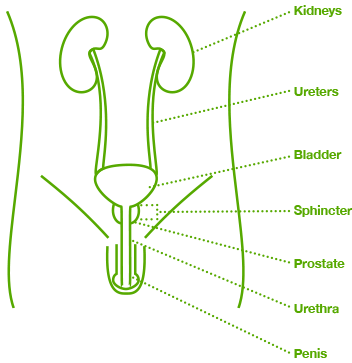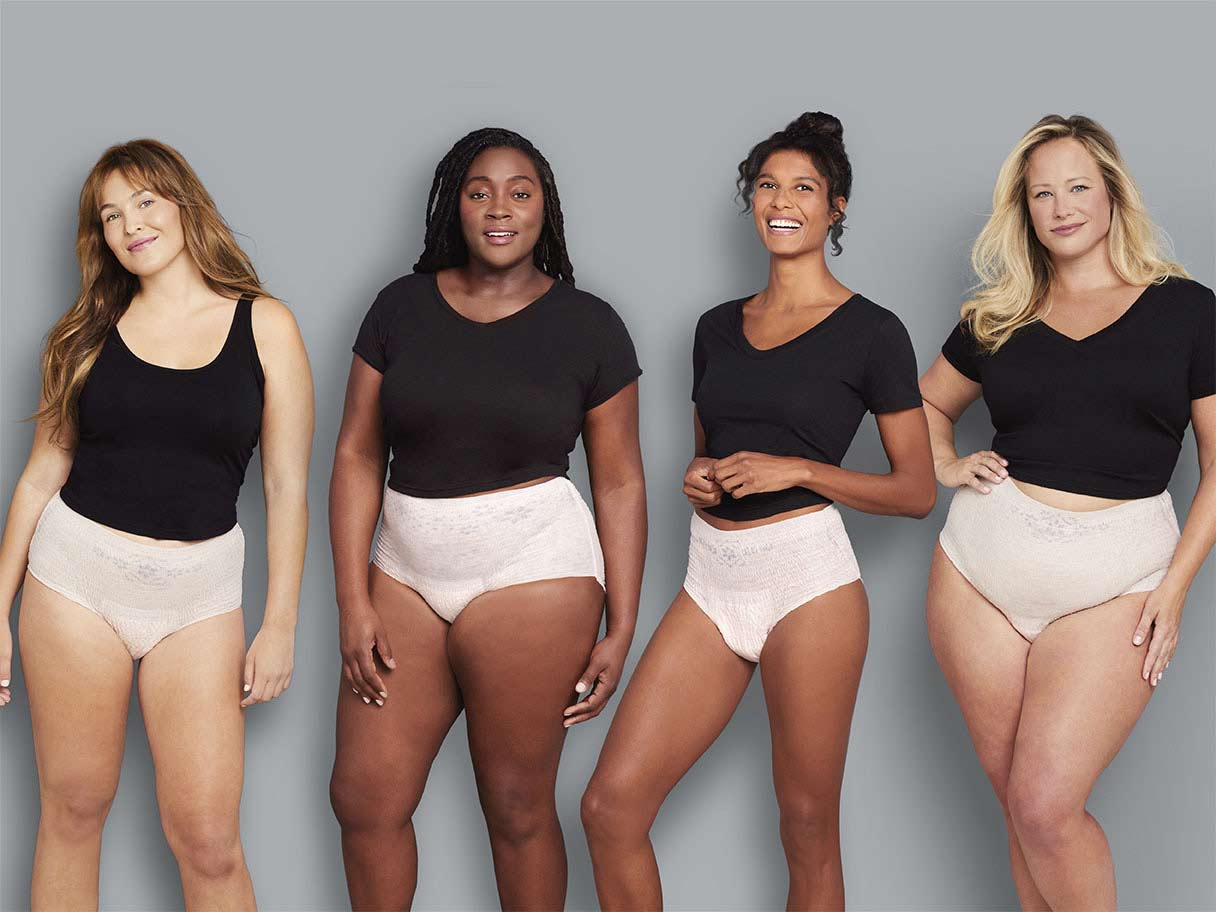Male Incontinence - Types, Symptoms & Risks
Male Incontinence
We created this guide to help you better understand urinary incontinence, and hopefully make leaks easier to manage - or even stop - everyday.
What is Urinary Incontinence?
Urinary Incontinence, or bladder leakage, is defined as any involuntary leakage of urine. It is a symptom or combination of symptoms related to the two functions of the lower urinary tract system: urine storage and bladder emptying. Symptoms are sometimes related to temporary or reversible conditions. Although it can be related to aging changes in our bodies, it is not the inevitable outcome of aging since many of the risk factors can be controlled with lifestyle change.

Causes of Urinary Incontinence in Men
As we mentioned before having an overactive bladder is not a disease. Often times, modifying everyday habits and lifestyle changes can help reduce or eliminate the symptoms. If the symptoms persist and become very bothersome, please do not hesitate to consult with your primary physician.
Temporary or reversible causes for Male Incontinence
- Urinary Tract Infection (UTI) - for some men once the UTI is treated they stop experiencing urine leakage.
- Constipation - the rectum is behind the bladder and shares the same nerve systems. Compacted stool can cause these nerves to be overactive and increase urinary frequency.
- Weakened Pelvic Floor Muscles - Kegel Exercises are an important tool for men to strengthen pelvic floor muscles. Pelvic floor muscles support all the pelvic organs and are critical to bladder, bowel and sexual function.
- Diet related - certain foods and drinks can act as diuretics or bladder irritants
- Obesity - Studies show that each 5-unit increase in body mass index(BMI) is associated with a 60-100 percentage increased risk of daily urinary incontinence.
- Side effect of new medications - heart and blood pressure medications, sedatives, and muscle relaxants.
- Psychological conditions (e.g., depression) - treatment of the condition may alleviate the urinary symptoms in some men. Also, some of the medications can alleviate and some may have this side symptom.
†Mandal, Anaya M.D Obesity and Urinary Incontinence (2015, March 16). Retrieved from http://www.news-medical.net/health/Obesity-and-Urinary-Incontinence.aspx
Urinary Incontinence Risk Factors
In order to store urine and empty the bladder normally, your pelvic floor muscles and the nerve systems that control bladder function must work together to hold urine and release it under your brain control. This complex orchestration of organs, muscles and nerve systems can be susceptible to getting timing and/or signals scrambled. The following are the risk factors for men in rank order††:
- Advancing Age
- Major depression
- Hypertension
- Prostate issues including BPH (benign enlarged prostate) or surgery associated with prostate cancer
- Diabetes
- Neurological diseases like Multiple Sclerosis (MS) and Parkinson's disease
- Spinal Cord injury
- Stroke
††Markland, A.D., Prevalence of Urinary Incontinence in Men: Results From the National Health and Nutrition Examination Survey Vol. 184, 1022-1027, September 2010)
Types of Urinary Incontinence in Men
Lower urinary tract symptoms consist of three groups of symptoms: urine storage, bladder emptying (while urinating), and post-bladder emptying (immediately after urinating). While there are several kinds of bladder leakage, the most common relate to storage symptoms. Specifically, these are:
- Stress urinary incontinence (SUI): Involuntary leakage that occurs when pressure (due to effort or exertion) is suddenly placed on your bladder. This could happen when you cough, laugh, sneeze, exercise or lift a heavy item.
- Urge urinary incontinence (UUI): A sudden, intense urge to urinate with, or followed by, urine leakage.
- Mixed urinary incontinence (MUI): When you experience both Stress and Urge Urinary Incontinence.
- Overactive bladder (OAB): A syndrome characterized by symptoms of urgency, with or without urge incontinence, usually with increased daytime frequency and nocturia.
- Nocturia: An equally common condition in men and women with about half of the people reporting at least 1 bathroom trip per night and about 1 in 4 report 2 trips per night.
Below are symptoms during & after urination that are more common in men:
- Slow stream:reduced urine flow rate in comparison to previous or to others
- Hesitancy:difficulty or delay initiating urination
- Intermittency:Stops and starts more than one or more times during urination
- Straining:muscular effort to initiate, maintain or improve urine flow
- Terminal Dribble:prolong final end of urination
How to Promote Bladder and Urinary Health in Men
Since obesity is a high risk factor for men developing urine leakage, losing excess weight can prevent the onset or help relieve symptoms of stress and mixed incontinence. The reduction of excess body weight will reduce added pressure put on your bladder and the pelvic floor, therefore reducing leaks when laughing, coughing, sneezing and other physical activities.
It is also important to avoid or minimize foods and drinks that can irritate the bladder. These include spicy and acidic foods (like tomatoes and citrus), dairy, alcohol, caffeine, carbonated drinks, fruit juice, and coffee (including decaf). These things are likely to trigger frequency and urgency to go to the bathroom, and may sometimes cause bladder leakage.
When you have bladder leakage you may be inclined to decrease your fluid intake. But actually, to keep your bladder healthy, you should stay hydrated by drinking approximately six to seven 8-oz glasses of water a day. This could vary slightly depending on your size and physical activity level, so listen to your body signals on how much to drink to stay hydrated. When you drink less water, your urine becomes more concentrated and may irritate the lining of the urethra (the tube from which urine leaves the body) and bladder – which can trigger bladder spasms, frequency to urinate and unexpected leaks.
Exercising is important in many ways including to strengthen internal abdominal and pelvic floor muscles. Pelvic floor health is essential to prevent and reduce both urine and bowel leakage. You can do this with Kegels, Zumba, Yoga, Pilates, Tai Chi. There are helpful YouTube videos to help learn how to correctly identify if you are contracting the pelvic floor muscles.
Exercising and walking combined with a healthy diet will help reduce excess weight and other urine leakage risk factors like diabetes.
Retrain your bladder to hold more urine, for longer. This works best for people who have urge or mixed incontinence. While awake, empty your bladder at regular intervals (such as twenty to thirty minutes or as long as you can manage). Each week, gradually increase the time between using the bathroom. Continue this exercise until you reach an interval of time that works for you.
You can also practice pelvic floor muscle exercises, known as Kegels, to strengthen the muscles that help control urination. By strengthening pelvic floor muscles through Kegels, you may reduce or eliminate urine leakage and the urge to go.
How to do Kegel exercises
First, locate your pelvic floor muscles by trying to stop your urine flow. This action is known as a pelvic floor muscle exercise (a.k.a. a Kegel). Now squeeze and hold those muscles for three seconds, relax for another three seconds and repeat 10 times. Do 3-4 sets of 10 squeezes per day, and you may begin to feel significant improvement controlling your bladder in just a few weeks.
Getting a good night’s sleep
Follow these simple steps to prevent nighttime accidents:
- Limit your fluids before bedtime
- Avoid bladder irritating foods like caffeine, alcohol, acidic foods, chocolate, hot spices, soda
- Try and urinate 2x before bed
- Keep the path to the bathroom clear and well lit
- Do some Kegel exercises
- Use an incontinence product specially designed for your protection need
How to control odour from bladder leakage
The best way to control odours is a 1-2-3 punch of good hygiene, staying hydrated and using clean disposable protective undergarments designed specifically to manage bladder leakage. Make sure to dispose of undergarment products in an airtight container, or, when traveling, in a plastic, zip-style bag. Consider taking urine-deodorizing tablets like vitamin C or supplements made for this purpose. Apple, pear, cherry or other non-citrus juices also help. Finally, find someone you trust to tell you honestly if an odour is present.
Staying in control
Here are some simple things you can do to make sure you’re always prepared when you’re out and about:
- Carry personal cleansing wipes and a spare Depend® product in your bag or briefcase
- Keep plastic, zip-style bags on hand for easy disposal
- Have an “emergency” change in your car or travel bag for peace of mind
- Set a schedule for regular changes
- Locate restrooms ahead of time
- Avoid caffeine, spicy and acidic foods or too much water
- Practice those Kegels
- Find the right Depend® male incontinence product
Bladder friendly foods
Be sure to check out some tips, tricks and tasty recipes for keeping your bladder happy and healthy with the right foods on the Depend®YouTube Channel.





